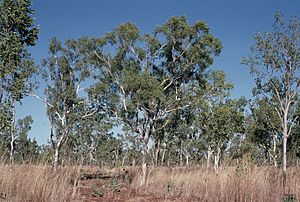Darwin box facts for kids
Quick facts for kids Darwin box |
|
|---|---|
 |
|
| Eucalyptus tectifica near the Gibb River | |
| Scientific classification | |
| Genus: |
Eucalyptus
|
| Species: |
tectifica
|
| Synonyms | |
|
|
The Eucalyptus tectifica, often called the Darwin box or grey box, is a type of tree found only in northern Australia. It has rough, flaky bark on its trunk and branches. Its leaves are shaped like spears or are slightly curved. This tree produces creamy white flowers and fruit that look like cones or barrels.
Contents
What is the Darwin Box Tree Like?
The Darwin box tree usually grows up to 15 m (49 ft) tall. It has a special woody lump at its base called a lignotuber. This helps the tree regrow if it gets damaged, like from a bushfire.
Bark and Leaves
The tree's bark is rough and can be fibrous or flaky. It's usually greyish. During the dry season, the tree might lose all or some of its leaves. This is called being deciduous.
Young plants and new shoots (called coppice regrowth) have egg-shaped leaves. These leaves are about 90–180 mm (3.5–7.1 in) long and 65–90 mm (2.6–3.5 in) wide. They also have a stalk, or petiole, connecting them to the stem.
Adult leaves are green on both sides. They are shaped like a spear or are slightly curved. These leaves are usually 90–225 mm (3.5–8.9 in) long and 9–30 mm (0.35–1.18 in) wide. Their stalks are 7–30 mm (0.28–1.18 in) long.
Flowers and Fruit
The flowers grow in groups, usually seven buds together. They are found at the ends of the branches. Each group of flowers grows on a thin stalk called a peduncle, which is 4–15 mm (0.16–0.59 in) long. The individual flower buds sit on smaller stalks called pedicels, about 1–8 mm (0.039–0.315 in) long.
Mature flower buds are oval or pear-shaped. They are 4–7 mm (0.16–0.28 in) long and 3–5 mm (0.12–0.20 in) wide. Each bud has a beak-shaped cap called an operculum. The tree flowers from October to December, and its flowers are creamy white.
After flowering, the tree produces woody fruit. These fruits are called capsules and can be shaped like a cone, cup, or barrel. They are 3–8 mm (0.12–0.31 in) long and 4–8 mm (0.16–0.31 in) wide.
How the Darwin Box Got Its Name
The Eucalyptus tectifica was first officially described in 1859. This was done by a botanist named Ferdinand von Mueller. He wrote about it in a science journal.
The second part of its scientific name, tectifica, comes from Latin words. These words mean "a roof" and "to make." This name was chosen because Aboriginal people used the bark of this tree to build shelters.
Where Does the Darwin Box Grow?
The Darwin box tree is found across northern Australia. You can see it from near Broome in Western Australia, all the way to Darwin in the Northern Territory. It also grows as far east as Normanton in Queensland. You can even find it on some islands in the Gulf of Carpentaria.
This tree likes to grow on hillsides and along creeks. It thrives in woodlands where the soil is sandy and rocky. This type of soil often sits over quartzite, sandstone, or basalt rocks.
Is the Darwin Box Tree Endangered?
Good news! The Darwin box tree is not considered to be in danger. Different government groups in Australia have checked on its numbers.
- The Western Australian Government's Department of Parks and Wildlife says it is "not threatened."
- The Northern Territory Government also lists it as "least concern" under their Territory Parks and Wildlife Conservation Act 2000.
- The Queensland Government also classifies it as "least concern" under their Nature Conservation Act 1992.
This means there are plenty of Darwin box trees around, and they are not at risk of disappearing.

